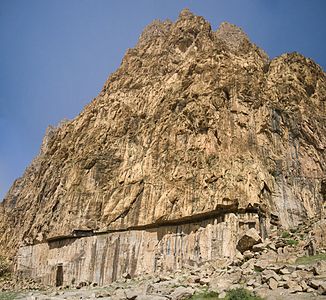|
Farhād Tarāsh The Farhād Tarāsh (Persian: فرهاد تراش), or Tarāsh-e Farhād,[1] is a long smoothed rock surface on Mount Behistun in western Iran. Located near the famous Behistun Inscription, its height is around 30 meters and its width is around 200 meters.[1] The retaining wall in front of it is c. 150 meters.[1] The work is registered as a national heritage in Iran, and it's the biggest work of such kind in Iran.[1] The Farhād Tarāsh has sparked interest from medieval geographers including Istakhri (died 957) and Yaqut al-Hamawi (died 1229) to travelers and archaeologists in modern times.[1] Creation  Various interpretations have been given about its creation.[1] In the early 19th century, H. C. Rawlinson believed that the Tarāsh-e Farhād was originally meant to become the rear wall of a palace of Khosrow II (r. 590–628) and was supposed to be decorated with a relief of Semiramis.[1] In the early 20th century, L. W. King and R. C. Thompson viewed it as a site for a palace of a Sasanian king.[1] Around the same period, A. V. Williams Jackson believed the Tarāsh-e Farhād to be the location of a planned inscription of Darius the Great (r. 522–486 BC), King of Kings of the Persian Achaemenid Empire.[1] Ernst Herzfeld also viewed it as an unfinished Achaemenid inscription, however he did not assign a specific date to it unlike Jackson.[1] Erich Schmidt, M. Golzari and D. Huff later viewed the Tarāsh-e Farhād as a field prepared for an inscription with its date of creation being unknown.[1] According to local tradition, "as reported in the 1960s" and noted earlier by A. V. Williams Jackson, the Tarāsh-e Farhād is attributed to the legendary architect of Khosrow II named Farhad.[1] Farhad features in Nizami Ganjavi's famous tragic romance Khosrow and Shirin, which he started writing in c. 1180.[1] According to Nizami (died 1209), Farhad completed three monumental works: the creation of the milk channel, a passage cut through the mountain at Bisotun, and the portrait of princess Shirin.[1] From the 15th to the 20th century, the story of Farhad and Shirin was a popular theme in various forms of visual art, including miniatures.[1] A miniature of c. 1575 depicts Farhad and Shirin near the pool at Mount Behistun, while the hillside on the same artwork shows a large flat piece of stone with effigies of Farhad and Shirin.[1] This slab "is clearly identifiable" as the Tarāsh-e Farhād.[1] The Encyclopedia Iranica adds:[1]
Another perspective of the context and creation of the Farhād Tarāsh was offered in the 1970s by architect W. Salzmann.[1] Salzmann conducted examinations of the cliff and the rock face in order to reconstruct the original Sasanian plans; according to his research, "a huge terrace" was planned to be built at 30 meters high and a massive ayvan (Middle Persian: āywan) was to be hollowed out of the rock.[1][2] According to Salzmann, the scale of the ayvan was probably approaching the Taq-e Kasra at Ctesiphon, the Sasanian royal capital.[1] He also noted that reliefs were going to be added on either side.[1] The Encyclopedia Iranica notes that Salzmann's hypothesis "is consonant with earlier theories suggesting a palace", or a fire temple built against the cliff; however, the Encyclopedia Iranica adds these theories are "impossible to prove conclusively".[1] Stone blocks on the hillsideRight next on the hillside, there are several hundred dressed stone blocks.[1] They were recorded by early European travelers who visited Iran, but they were not identified as being from the Sasanian era until Heinz Luschey managed to examine them.[1] Luschey concluded that these stones were made of the same rock as the Farhād Tarāsh.[1] GalleryReferencesSources
Information related to Farhād Tarāsh |
Portal di Ensiklopedia Dunia


